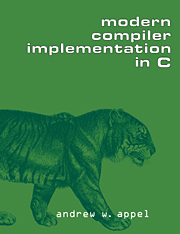Book contents
- Frontmatter
- Contents
- Preface
- Part I Fundamentals of Compilation
- 1 Introduction
- 2 Lexical Analysis
- 3 Parsing
- 4 Abstract Syntax
- 5 Semantic Analysis
- 6 Activation Records
- 7 Translation to Intermediate Code
- 8 Basic Blocks and Traces
- 9 Instruction Selection
- 10 Liveness Analysis
- 11 Register Allocation
- 12 Putting It All Together
- Part II Advanced Topics
- Appendix: Tiger Language Reference Manual
- Bibliography
- Index
10 - Liveness Analysis
Published online by Cambridge University Press: 05 June 2012
- Frontmatter
- Contents
- Preface
- Part I Fundamentals of Compilation
- 1 Introduction
- 2 Lexical Analysis
- 3 Parsing
- 4 Abstract Syntax
- 5 Semantic Analysis
- 6 Activation Records
- 7 Translation to Intermediate Code
- 8 Basic Blocks and Traces
- 9 Instruction Selection
- 10 Liveness Analysis
- 11 Register Allocation
- 12 Putting It All Together
- Part II Advanced Topics
- Appendix: Tiger Language Reference Manual
- Bibliography
- Index
Summary
live: of continuing or current interest
Webster's DictionaryThe front end of the compiler translates programs into an intermediate language with an unbounded number of temporaries. This program must run on a machine with a bounded number of registers. Two temporaries a and b can fit into the same register, if a and b are never “in use” at the same time. Thus, many temporaries can fit in few registers; if they don't all fit, the excess temporaries can be kept in memory.
Therefore, the compiler needs to analyze the intermediate-representation program to determine which temporaries are in use at the same time. We say a variable is live if it holds a value that may be needed in the future, so this analysis is called liveness analysis.
To perform analyses on a program, it is often useful to make a control-flow graph. Each statement in the program is a node in the flow graph; if statement x can be followed by statement y, there is an edge from x to y. Graph 10.1 shows the flow graph for a simple loop.
Let us consider the liveness of each variable (Figure 10.2). A variable is live if its current value will be used in the future, so we analyze liveness by working from the future to the past. Variable b is used in statement 4, so b is live on the 3 → 4 edge.
Information
- Type
- Chapter
- Information
- Modern Compiler Implementation in C , pp. 218 - 234Publisher: Cambridge University PressPrint publication year: 1997
